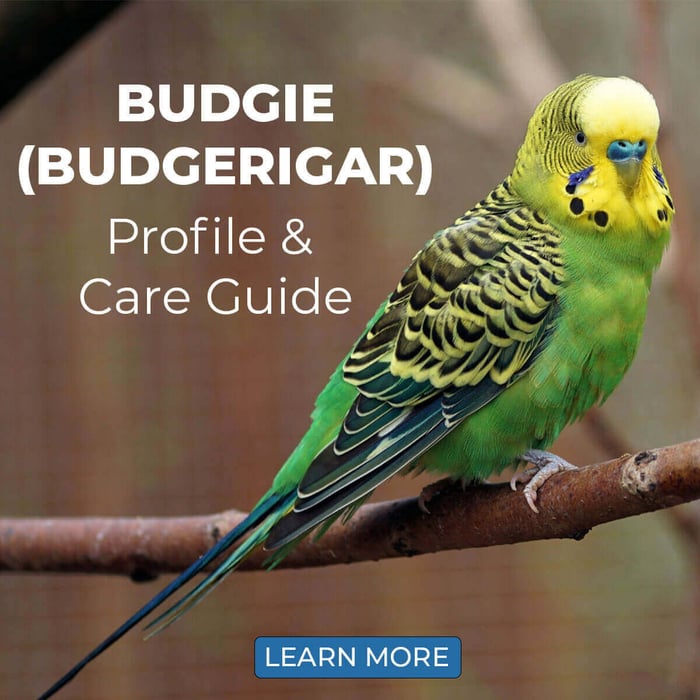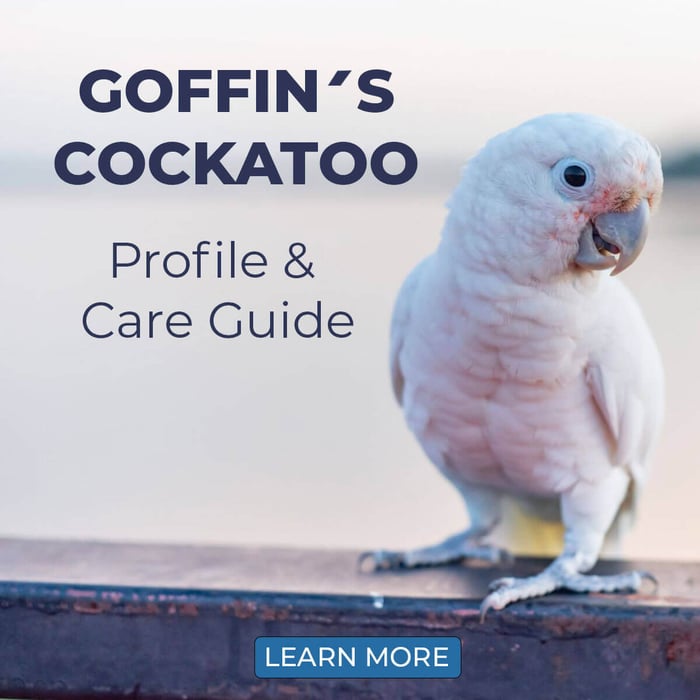Indian Ringneck Parrot (Rose-Ringed Parakeet) - Profile & Care Guide
| Common name: | Indian ringneck parrot, rose-ringed parakeet |
| Scientific name: | Alexandrinus krameri, formerly Psittacula krameri |
| Length: | Up to 40 cm with tail |
| Weight: | Up to 130 grams |
| Lifespan: | 20+ years |
| Origin: | 15-25 years, up to 30 |
| Noise Level: | Medium |
NATURAL HABITAT
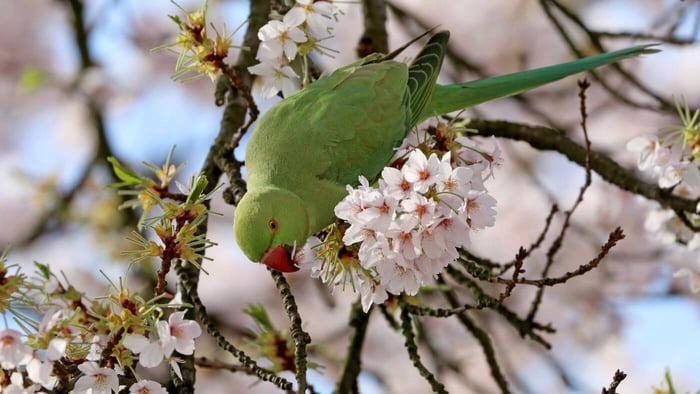
Alexandrinus krameri boasts a very wide natural range. In Africa, they can be found from Senegal on the western end to Ethiopia on the eastern side. They reach into Egypt in the north and Uganda in the south. In Asia, the species' distribution extends from Afghanistan in the west to as far east as Vietnam.
The Indian ringneck parrot is not very picky when it comes to habitat. It naturally inhabits dry grasslands and savanna, as well as more shrubby and even forested areas and wetlands. This parrot's favourite environment, though? Cities and farmland, where food is very easy to find. Its hardiness, adaptability, love for human food, and the pet trade have made this species incredibly invasive. Feral populations can be found around the world, causing trouble for native species in many areas.
Among other countries, the rose-ringed parakeet can now be found in the USA, much of Europe, various Arab and South/Central American countries, and more. London, in particular, has a huge population. Going to Hyde Park to feed apples to the ringnecks is now, in fact, a favourite tourist activity!
INDIAN RINGNECK APPEARANCE
Rose-ringed parakeets are naturally green in colour, with a bright red beak. They are shaped like typical parakeets, with their tails sometimes reaching almost the same length as their slender bodies. The common name "ringneck" was derived from the fact that the males of the species do indeed sport a black to pink ring around their neck, which extends to the cheeks and stops at the beak.
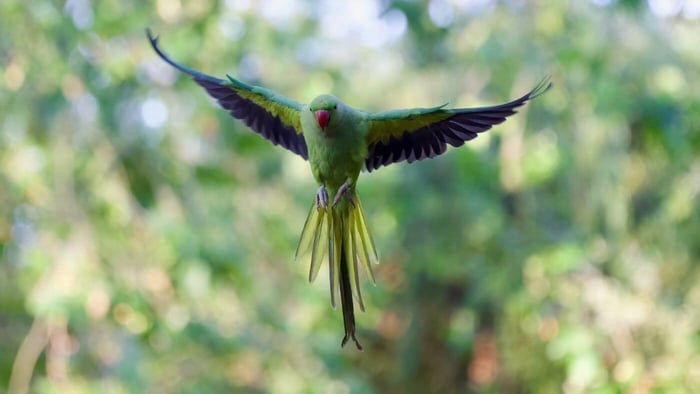
Their long history in aviculture has given breeders plenty of time to develop a wide range of Indian ringneck parrot colours through selective breeding. You'll now find these parrots in a veritable rainbow of different shades, including natural green, yellow, different shades of blue and blueish-violet, white, and even combinations where the head is a different colour than the body.
Determining the gender of an Indian ringneck parrot is not considered possible before the bird has reached maturity at around three years unless you opt for a DNA test. In adults, there are some good indicators:
- The neck ring that earned these parakeets their name only shows up on males. If your bird has a pronounced ring, it's a male. Again, though, this trait can take quite a while to show up—and albino or lutino birds never get a ring.
- Males will "flirt" by slightly extending their wings and tail feathers, displaying, whistling or talking, and performing a "bopping" dance.
- Adult females tend to be somewhat stockier and less dainty than males. Some parrot owners report their tail feathers being slightly shorter.
INDIAN RINGNECK INTELLIGENCE & PERSONALITY
Although they're among the most charming parrots, Indian ringnecks are not meant for those who live a busy life but still expect a cuddly bird. They're extremely intelligent and demanding, get bored easily, and are known for becoming nippy and destructive if left to their own devices. If you work a 9-5, it's best to either get two ringnecks or opt for a different parrot species.
If you do have the patience and time to hang out with, play with, and train your Indian ringneck, then you've got a fantastic bird on your hands. They can be extremely loving and loyal—even cuddly, as most well-socialized birds acquire a great love for neck scratches. They're not shy at all, with the males especially being known for their fancy, almost "arrogant" strut.
A well-socialized ringneck will enjoy forming part of your family, hanging out and inspecting everything that goes on in the house. Everyone should handle and feed the bird on a regular basis, because they do have a tendency to bond with one person and become aggressive towards others.
Training is our recommended activity, as it has multiple advantages. Spending time teaching your bird to do tricks or to talk not only stimulates desirable behaviours but also strengthens your bond. The first "tricks" should include handy ones like the bird learning to step up and down, go into a travel cage, and allow you to cut its nails.
INDIAN RINGNECK NOISE LEVEL & TALKING ABILITY
Loudness is a relative concept for parrots, as all species produce a lot of noise, but Indian ringnecks tend to fall somewhere in the middle. Their flock call can be very piercing, though, and the males, in particular, enjoy spending much of the day chattering and talking. If you're sensitive to noise, these birds are unfortunately not for you.
As for whether they can talk, the answer is yes! The males (and sometimes females) of this species are pretty talented talkers. If you train your Indian ringneck parrot well, which can easily be done by repeating the desired word or phrase throughout the day, it can end up acquiring an impressive vocabulary of speech, whistles, and sounds.
FEEDING & NUTRITION FOR YOUR INDIAN RINGNECK
In the wild, this mostly herbivorous species primarily consumes different types of seeds, making it a granivore. Indian ringneck parrots will also eat berries and fruits, nuts, flower buds, and even the occasional insect. Ringnecks are also considered an agricultural pest in some areas, as flocks raid cereal grain and legume crops, orchards and more. They can also dominate residential bird feeders.
What should you feed your pet Indian ringneck parakeet? It's important to keep their natural diet in mind, but we'd like to stress that you shouldn't offer a seed-only diet. Unfortunately, we don't have access to the same variety of seeds these birds eat in the wild, and dried parrot seed mixes can lead to malnutrition if you feed them exclusively. It's much better to feed a high-quality complete parrot pellet as a staple.
You can supplement with:
- Daily servings of fresh vegetables and leafy greens.
- A high-quality parrot seed mix.
- Occasional fresh fruits.
- Sprouted seeds.
- Cooked grains like rice and pasta.
- Foraged foods like wild grasses, certain flowers, and fresh parrot-safe branches.
HOUSING FOR YOUR INDIAN RINGNECK
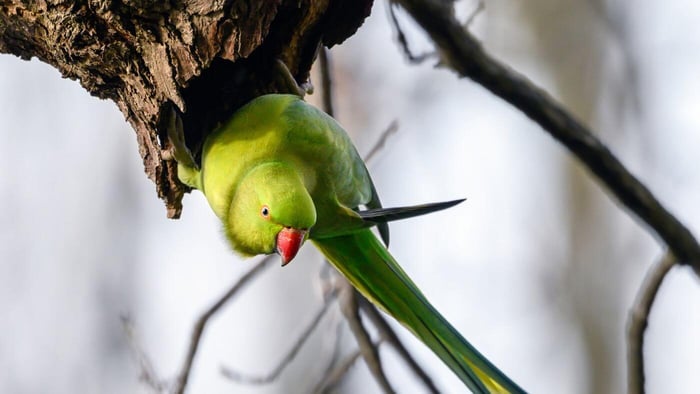
As with any parrot, when it comes to choosing a cage for your Indian ringneck, it's important to go as large as possible. These are medium-sized birds with long tails that need quite a bit of space to stretch their wings. The exception would be if you leave the cage door open all day so your parrot can roam free, in which case you can stick to the minimum cage size of around 2 x 2 x 3 ft (60 x 90 cm).
Provide various perches made of natural wood, especially near the top of the cage. Make sure your Indian ringneck has access to multiple food and water stations. And don't forget the toys: no one can spend 24/7 with their bird, and parrots need plenty of entertainment in their cage. Rotate a variety of toys for medium-sized parrots on a weekly basis to keep things interesting.
Provide foraging toys, soft wood toys, natural perches and branches, and anything else you can think of for your feathered friend to destroy.
Tip: Don't let your parrot wither away in its cage. Set up a nice playground on top of the cage or another surface so it can fly around and see a bit more of the world. Do be sure to parrot-proof the room and supervise your bird.
FEATHER PLUCKING IN INDIAN RINGNECKS
Feather plucking does happen in Indian ringnecks. This self-damaging behaviour is a sign of stress, boredom, or health issues. If you spot your bird plucking, a prompt visit to an avian veterinarian is crucial to rule out health issues and to discuss behavioural interventions. The longer a parrot plucks, the more difficult it tends to be to get it to stop.
FACTS
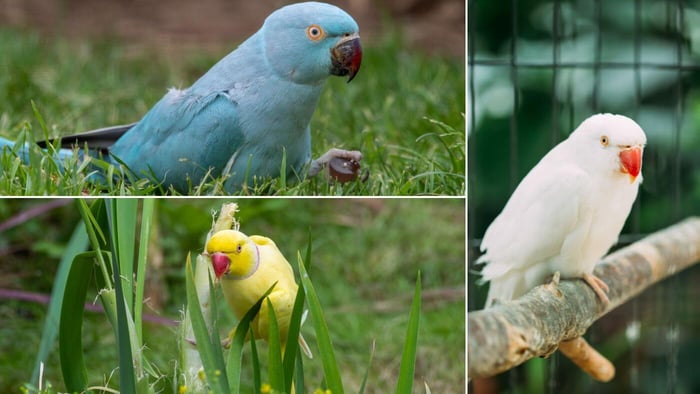
- There are four recognised subspecies of Indian ringneck parrot: Alexandrinus krameri krameri (African Indian ringneck), Alexandrinus krameri parvirostris (Abyssinian Indian ringneck), Alexandrinus krameri manillensis (Indian ringneck), and Alexandrinus krameri borealis (Boreal Indian ringneck). There isn't much difference between them, although the Asian subspecies are slightly larger than the African ones.
- A 2019 DNA study led the authors to suggest that Indian ringnecks should be moved out of the genus Psittacula. As such, Psittacula krameri received the new scientific name of Alexandrinus krameri, along with some other pretty major revisions.
- A charming scientific study concludes that rose-ringed parakeets actually have a foot preference for holding their food. There were more left-footed birds than right-footed ones! Which foot does your parrot prefer?
- The IUCN Red List considers Alexandrinus krameri to be a species of Least Concern. Not surprising given that human activity has actually allowed it to expand its range and numbers, rather than diminishing them.
CONCLUSION
Indian ringneck parrots, also known as rose-ringed parakeets, are popular pet parrots thanks to their quirky personalities and talking abilities. They can make fantastic additions to the right family, but keep in mind that they do need a lot of attention and training in order to prevent undesirable behaviours like biting.
To view other Parrot Profiles & Care Guides, visit our Alphabetical list of Parrot Fact Sheets by visiting: https://parrotessentials.co.uk/blog/parrot-profiles-care-guides
Braun, M. P., Datzmann, T., Arndt, T., Reinschmidt, M., Schnitker, H., Bahr, N., ... & Wink, M. (2019). A molecular phylogeny of the genus Psittacula sensu lato (Aves: Psittaciformes: Psittacidae: Psittacula, Psittinus, Tanygnathus,† Mascarinus) with taxonomic implications. Zootaxa, 4563(3), zootaxa-4563.

